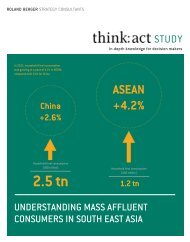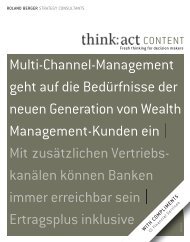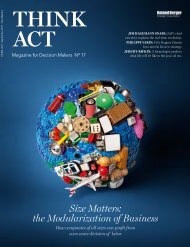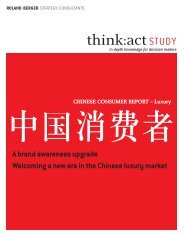Automotive inSIGHTS 1/2007 - Roland Berger
Automotive inSIGHTS 1/2007 - Roland Berger
Automotive inSIGHTS 1/2007 - Roland Berger
You also want an ePaper? Increase the reach of your titles
YUMPU automatically turns print PDFs into web optimized ePapers that Google loves.
6 | <strong>Automotive</strong> Insights | Low Cost Cars<br />
ferences are two of the most important success factors.<br />
Market selection involves evaluating the regulatory environment,<br />
economic situation and consumer behaviors,<br />
as well as the activities of other OEMs. Further success<br />
factors include adapting vehicles for local markets,<br />
operating platform strategies, extensively standardizing<br />
components and production processes, choosing low cost<br />
locations. To determine which country presents the highest<br />
potential and is most favorable for low cost car production,<br />
it is important to examine each individual market.<br />
In the US, the low cost car segment is expected to grow<br />
to 0.7 million vehicles by 2012<br />
The fi rst low cost car ever made in the USA was Henry<br />
Ford‘s Model T. In its last year of production, the Model T<br />
costed USD 380 – the equivalent of USD 4,200 at today‘s<br />
prices. But cars have become less afford able over time.<br />
Between 1980 and 2003, the average vehicle selling<br />
price rose by 2.2 percent per annum, growing faster than<br />
all but the top 5 percent of US family incomes. At the<br />
same time, high fuel prices are driving down demand for<br />
large SUVs while boosting sales of small cars.<br />
Through 2012, the entry level car segment in Western<br />
Europe will grow by only 0.3 million vehicles<br />
Despite Western Europe‘s prosperity, car prices have outgrown<br />
the wages. As a result, many consumers are becoming<br />
more and more willing to compromise on comfort,<br />
basing car purchase decisions mainly on price instead.<br />
One vivid illustration of this phenomenon is the unexpected<br />
success of Renault‘s Dacia Logan. New models in the<br />
low cost, entry-level segment have considerable potential<br />
if they are fuel-effi cient and inexpensive to run.<br />
Domestic entry-level sales in the Japanese automotive<br />
market are expected to grow from 2.5 million vehicles<br />
in 2006 to 2.6 million vehicles in 2012<br />
Entry-level vehicles in Japan fall into two categories:<br />
Compact cars with engine displacement between 1,000<br />
cc and 1,300 cc and "Kei" or sub-compact cars with<br />
engine displacement of less than 660 cc. The entry-level<br />
vehicle segment, including sub-compact cars, accounted<br />
for 43 percent of the passenger car market in 2005, a<br />
slight increase from the 41 percent market share in 2001.<br />
Japan presents an interesting contrast to other vehicle<br />
markets in that the trend seems to be moving from larger<br />
to smaller vehicles. Foreign OEMs who aim to take advantage<br />
of this trend are nevertheless likely to face numerous<br />
challenges, given the strength of domestic OEMs.<br />
We expect China to be the strongest growth market, with<br />
a volume of 2.6 million entry-level cars by 2012<br />
Currently, the cheapest cars in the world are produced<br />
and sold in China, with MSRPs for many models starting<br />
below EUR 3,000. In China, the upper starting price limit<br />
for A segment cars is around EUR 4,000.<br />
> China‘s entry-level segment is growing rapidly and<br />
represents one third of the market<br />
> The quality of Chinese production is improving and<br />
the market still has plenty excess capacity<br />
> Local Chinese OEMs are gearing up for exports to<br />
developed markets<br />
Global sales forecast of A/B-segment vehicles ('000 units)<br />
4.2%<br />
455 582<br />
Mexico<br />
2006<br />
8,7%<br />
428 705<br />
USA<br />
3.9%<br />
1,204 1,513<br />
Brazil<br />
0,8%<br />
5,471 5,756<br />
Western Europe<br />
4.1%<br />
17,685<br />
13,935<br />
7.8%<br />
726 1,138<br />
Eastern Europe<br />
8.7%<br />
226 441<br />
Russia 1)<br />
7.6%<br />
980 1,519<br />
India<br />
13.4% 133 216<br />
1,243 2,640<br />
China<br />
16.3%<br />
42 104<br />
Thailand<br />
8.4%<br />
South Korea<br />
6.4%<br />
265 385<br />
Malaysia<br />
0.6%<br />
2,508 2,599<br />
Japan<br />
2012<br />
A/B Worldwide<br />
1) For Russia comparison of 2006 vs. 2014 CAGR 2006-2012 Source: J.D. Power; <strong>Roland</strong> <strong>Berger</strong> market model















